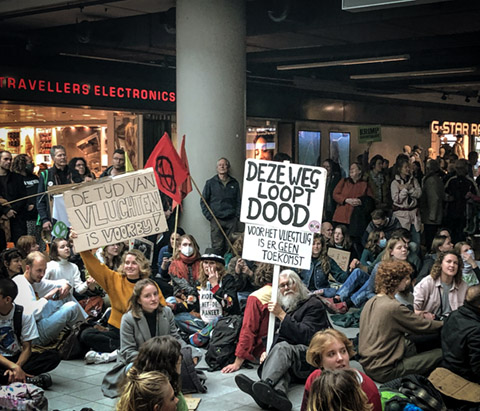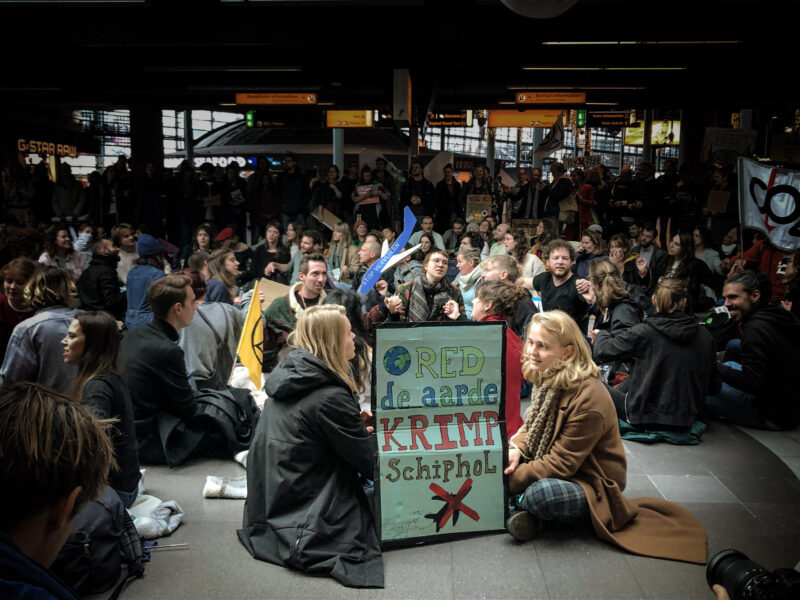
They helped shut down Schiphol
Running up that runway
‘So, what was it like sitting underneath the plane?’
‘Cold!’ Artemis, Brisa, Thomas, and Daisy reply together, laughing.
The four activists, three of whom graduated from the University of Groningen earlier this year with degrees in global responsibility and leadership – Thomas will graduate next year – are speaking from Berlin, where they’re attending a climate education conference.
Huddled close on a small couch, trying to get everyone into the frame of our Zoom call, they recount their experience being detained along with approximately two hundred other activists who helped block private jets at Schiphol from taking off during an Extinction Rebellion (XR) and Greenpeace-led protest on November 5.
They were there to try to force the airport to meet their climate demands: stop polluting and develop a climate plan, scrap unnecessary short-haul and private flights, stop the ‘greenwashing’ advertisements and CO2 offsets, and set climate rules for aviation.
Storming the tarmac
The young activists – referred to in this article by their activist names, to protect their identities – had travelled by train to Amsterdam the day before the protest. Early the next morning, they set out on the long walk to a highly restricted back section of Schiphol’s airfield. The trek across parks and fields took a couple of hours, they recount. When the protesters finally arrived, they stormed the tarmac, some scaling over the security fence with ladders, most just making an adrenaline-fuelled rush through gaps in the fence, past military police and airport staff.
At times it was a chill atmosphere almost
About five hundred activists managed to get through. They washed across the airfield to the private jets in a scattered sea of bodies and bikes, homemade banners in hand and black-and-green XR flags held aloft on sticks.
‘I think it was really cool when we arrived at the private jet area’, says Daisy. ‘At that moment there was this realisation that we had never seen that side of Schiphol before, or how this works on the ground, and suddenly we were sitting underneath one of those jets’, she explains.
Mostly waiting
When you see these events unfolding on television or in pictures in newspapers or online, it all seems very dramatic, those snapshots of chaotic moments with protesters cheering under planes before being dragged away or police chasing cyclists across the tarmac. In reality, the activists say, it’s mostly just waiting.
At times, it was a chill atmosphere almost, where nothing happened for a few hours’, Thomas says. They spent their time going on walks, playing card games, making music with some guitars that were brought along, and having yoga breaks to stave off the stiffness from sitting on hard surfaces.
When the police came close to them, everyone would sit back down again, lock arms, and brace themselves in case they would try moving them.

The bikers were the main communication stream of the protest, Artemis explains. When they would bike past, they would start chants, or bring tea or soup that was snuck over the fence from protesters on the other side.
They would also pass messages – ‘Mic check! We are in the Guardian, or the Washington Post, or you can expect the police in the next fifteen minutes to start arresting’, Artemis recounts.
Police violence
‘The mood changed after they got dragged away’, Brisa remembers. ‘It was emotional when someone got carried away. Everyone at a plane close by would sing – “You are not alone, you are not alone!” In a way you’re saying thank you so much for joining and we are staying for you.’
During non-violent disruptive actions like these, police must warn protesters to stop what they are doing three times before using force to remove and arrest them. Though – as Schiphol protesters were warned during action training and legal briefings – this does not always happen.
The way people were carried away was quite brutal
Thomas remembers seeing people to his left getting hit with sticks by the police or tackled to the ground. ‘I thought at that moment the police were quite aggressive. It was a bit scary. The way people were carried away was quite brutal in some cases, especially the bikers.’
‘The police use a lot of violence, and they also don’t really like it if you protest’, says Hannah Prins, member of Extinction Rebellion’s legal circle and Stop Ecocide ambassador. ‘They pretend like your right to demonstrate is more like a favour.’
Not all protests are handled equally, Hannah feels, with ‘police treating climate protesters much harsher than they do the farmers’.
Detention
After protesters were removed from under the planes and taken into custody, they were taken to the police stations around Schiphol airport or kept on buses for the duration of their six-hour detention.
The experience on the bus was ‘at times really bad’, says Thomas. There were few opportunities to use the toilet – a patch of grass outside the bus – and they were without access to food or water for the first four hours. One protester even collapsed while locked in the bus, he says.
No one from the group was formally arrested, because like most protesters, they chose to go anonymously, which involves covering your fingerprints with sticky paste or scraping them off with needles, not carrying IDs, and refusing to answer questions from the police.
The Netherlands is a relatively safe place to protest in, they say, but real risks remain with fines, arrest, criminal prosecution, and emotional distress all possible. For these reasons, organisers provide lawyers and free therapy during and after the events.
Personal attacks
But these are not the only risks to activists.
Rivka, who also attended the protest, is fifteen and barely looks that old. She was targeted with online abuse after the protest. Trolls found out who she was from Twitter and quickly started calling her mother’s workplace trying to get her fired.
The police treat climate protesters much harsher than they do the farmers
They also found a picture of the family on vacation in Bali when Rivka was a child. That was the evidence they used to attack her and her family, calling them hypocrites because they flew. ‘I was young, I didn’t even know about climate change. It’s amazing that anyone would even make time for this’, she says.
Personal attacks are part of being politically active in today’s world, the group knows, but they choose to carry on with protests anyway.
Eco-anxiety
The actions themselves may appear extreme or even absurd at times – people glued to objects and streets, food-splashed paintings in museums – but according to Artemis, Brisa, Thomas, and Daisy, they are needed to inspire governments and companies to change their ways.
‘I think the term eco-anxiety is very prevalent in our generation’, says Thomas. ‘I would much rather spend my time on other things, but I think it is just necessary so we can have a future, or our children might still have a future.’
Tessel, a final year medical student, who took part in the legal demonstration at Schiphol’s terminal, only began being active this year, after growing more worried about climate change. ‘When you follow the topic, it’s really on your mind almost every day. There is a point when you think: I should do something about this.’
Becoming active in the movement was her way of doing something about it – to tell the government that she and people like her are here and ‘to participate in the solution’.
Still, it is hard for the activists to stay optimistic. ‘What are we going to get out of this? One Saturday, one action?’ Tessel asks. ‘But it feels like it’s more than nothing at least.’
After the protest, the Socialist Party and Groenlinks factions in the Amsterdam municipal council put forth a motion to research the possibility to restrict and potentially ban commercial private jets flying from Schiphol, and to introduce a higher kerosene tax for private jets. The motion passed.